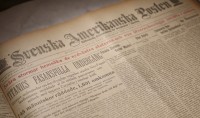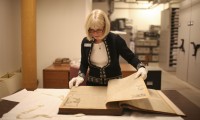 When 1.3 million Swedes emigrated to the United States in the late 19th and early 20th centuries, they were supported by the communities their predecessors had established. Sweden had a 90% literacy rate in 1850, one of the highest in the world, so a larger than usual proportion of the farmers and labourers who sought out a new life in the prairies and cities of the Midwest could read and write. As a result, more than 600 Swedish-language newspapers were established in the United States, second only in number to the German-language press. Initially it was religious newsletters tied to a particular church or denomination that gained a foothold in the immigrant communities, but after the Civil War the Swedish secular press flourished. These newspapers were vital sources of news from the motherland and around the world, information on how to acclimate to their new country (recipes for unfamiliar foods, English language lessons, tackling political issues, etc.).
When 1.3 million Swedes emigrated to the United States in the late 19th and early 20th centuries, they were supported by the communities their predecessors had established. Sweden had a 90% literacy rate in 1850, one of the highest in the world, so a larger than usual proportion of the farmers and labourers who sought out a new life in the prairies and cities of the Midwest could read and write. As a result, more than 600 Swedish-language newspapers were established in the United States, second only in number to the German-language press. Initially it was religious newsletters tied to a particular church or denomination that gained a foothold in the immigrant communities, but after the Civil War the Swedish secular press flourished. These newspapers were vital sources of news from the motherland and around the world, information on how to acclimate to their new country (recipes for unfamiliar foods, English language lessons, tackling political issues, etc.).
Most of the Swedish papers are now available only in libraries, historical societies and institutions of higher learning, either in microfilm/microfiche format or in large bound volumes of paper issues. Come next year, that will change. The National Swedish Library in Stockholm, the American Swedish Institute, the Minnesota Historical Society, and the Swenson Swedish Immigration Research Center at Augustana College in Illinois are working together to digitize every issue of the Swedish-language press they can find.
 The project began in 2008 with a discussion between people from the American Swedish Institute, the Minnesota Historical Society and Augustana College on how to make some of these important primary sources more widely available. They reached out to the National Swedish Library and the project took off. (Relevant side-note: The American Swedish Institute is housed in a beautiful French chateau-style 1903 mansion in downtown Minneapolis that once belonged to Swan Turnblad, owner and publisher of the Swedish-language weekly Svenska Amerikanska Posten, peak circulation 40,000. After his wife died in 1929, Turnblad donated the mansion, the Posten and the Posten‘s office building to the American Institute for Swedish Art, Literature and Science, today known as the American Swedish Institute. The paper went out of business in 1940.)
The project began in 2008 with a discussion between people from the American Swedish Institute, the Minnesota Historical Society and Augustana College on how to make some of these important primary sources more widely available. They reached out to the National Swedish Library and the project took off. (Relevant side-note: The American Swedish Institute is housed in a beautiful French chateau-style 1903 mansion in downtown Minneapolis that once belonged to Swan Turnblad, owner and publisher of the Swedish-language weekly Svenska Amerikanska Posten, peak circulation 40,000. After his wife died in 1929, Turnblad donated the mansion, the Posten and the Posten‘s office building to the American Institute for Swedish Art, Literature and Science, today known as the American Swedish Institute. The paper went out of business in 1940.)
The Minnesota Historical Society has been in the business of digitizing newspapers for nearly a decade, said Jennifer Jones, director of library and collections. Its digitized newspaper collection includes such defunct papers as the St. Paul Globe and Minneapolis Journal, and African-American and Ojibwe-language publications. Collecting and preserving newspapers is part of the society’s mission, mandated by state law requiring all newspapers that publish public notices to archive their publications.
The Royal Swedish Library has completed the digitization of about two dozen Swedish-American newspapers, Jones said. The national library has collected virtually everything printed in the Swedish language since 1661, and had original copies, which are superior to drawing from microfilm in the digitizing process.
The Historical Society, Jones said, is now taking the lead on the final phase of the project: making those images easily accessible.
“Since we have all the background in making that successful, we can build on that,” Jones said. “The real challenge for us is trying to find a way to make something written in Swedish usable for people in the United States.”
 That is a challenge since online translators are sketchy at best. The idea is to make these invaluable resources on the history and developement of Swedish immigrant communities in the United States accessible to everyone, so they’re working on a solution that will provide more accurate English translations of the papers.
That is a challenge since online translators are sketchy at best. The idea is to make these invaluable resources on the history and developement of Swedish immigrant communities in the United States accessible to everyone, so they’re working on a solution that will provide more accurate English translations of the papers.
After six years of work, the digitization project is almost done. The plan is to launch the database next year. At first it will be made available to genealogists, researchers, people of Swedish descent looking for information about their families. In 2016, it will be opened to the general public, hopefully with the translation issues resolved.
Online translators (eg Google translate) are comically dreadful. Real online translators, however, can be fantastic. I’m thinking about your shorthand volunteers from a year or two back. I’ll bet there are hordes (or at least an enthusiastic dozen) of retired Swedish-American amateur history buffs who would love to work on this stuff. The Minnesota Historical Society needs to crowdsource this. Maybe Garrison Keillor can advertise for them.
Are you kidding? Genealogists love this stuff, and I know more than a few who read, write, and speak Swedish. There are entire associations made up of ethnic Swedes, and knowing Swedes, they’re already organizing this project. I mean, look at who is involved in it! Granted, translation is trickier than transcription, but given that this is starting with printed material (as opposed to handwritten) using the team approach would go quickly and make for accurate translations. I can hardly wait (though my Scandinavian ancestors rode in earlier by invading the British Isles first…).